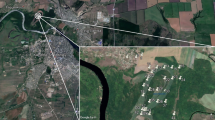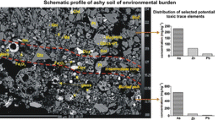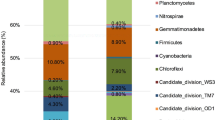Abstract
Studied technosols represent a unique system of a 50-year-old environmental burden after dam failure of coal-ash pond. The released ashes rich in arsenic with a thickness of 1–2 m were covered by a 40-cm thick layer of soil. Long-term exposure and selection pressure of elevated concentrations of arsenic (a range of 93–634 μg/g) induced the formation of the specific adapted autochthonous microorganisms. The phylum Proteobacteria was identified as a dominant phylum in the soils and represented only by one class—Gammaproteobacteria with six species. The species of phylum Firmicutes, Bacteroidetes and Actinobacteria were also identified. Thirty-three species of identified autochthonous microscopic fungi belong to 18 genera with the most abundant Mortierella alpina (Zygomycota). The most frequent identified mycobiota belongs to genera Penicillium, Aspergillus, Trichoderma and Alternaria. The isolates of Alternaria triticina, Bionectria ochroleuca, Chrysosporium queenslandicum, Exophiala psychrophila, Metarhizium robertsii, Trichoderma rossicum and Phlebia acerina were identified for the first time in Slovakia. Despite the stimulation of autochthonous community by nutrient medium and augmentation by native species, As leachability was relatively low—on average 5.63 wt.%, 9.23 wt.% and 17.04 wt.% of the total As for inoculated Pseudomonas chlororaphis ZK-1, Pseudomonas putida ZK-5 and Aspergillus niger, respectively. The highest As leachability was achieved through biostimulation of autochthonous microbiota using liquid SAB medium (34.73 wt.% of total As content). Additionally, microbial activity was efficient in the biovolatilization of As from soils (∼70 wt.% of the total As volatilized). It appears that bioremediation using microorganisms represents one of the possible ways of As removal from soils containing coal-combustion ashes with elevated concentrations of As.




Similar content being viewed by others
References
Akhtar, M. S., Chali, B., & Azam, T. (2013). Bioremediation of arsenic and lead by plants and microbes from contaminated soils. Research in Plant Sciences, 1(3), 68–73.
Anonymous. (2004). Ministry of Agriculture, Environment and Regional Development of the Slovak Republic-Law no. 220/2004 Z.z. on the Protection and Utilization of Agricultural Soil (in Slovak).
Bolanz, R. M., Majzlan, J., Jurkovič, Ľ., & Göttlicher, J. (2012). Mineralogy, geochemistry, and arsenic speciation in coal combustion waste from Nováky, Slovakia. Fuel, 94, 125–136.
Burgstaller, W., & Schinner, F. (1993). Leaching of metals with fungi. Minireview. Journal of Biotechnology, 27(2), 91–116.
Cai, L., Liu, G., Rensing, C., & Wang, G. (2009). Genes involved in arsenic transformation and resistance associated with different levels of arsenic-contaminated soils. BMC Microbiology, 9(4), 1–11.
Camargo, F. A. O., Okeke, B. C., Bento, F. M., & Frankenberger, W. T. (2005). Diversity of chromium-resistant bacteria isolated from soils contaminated with dichromate. Applied Soil Ecology, 29(2), 193–202.
Čerňanský, S., Urík, M., Ševc, J., Šimonovičová, A., & Littera, P. (2006). Microscopic filamentous fungi from locality Pezinok—Kolársky vrch (Slovakia)—occurrence and biovolatilization properties for arsenic. Acta Environmentalica Universitatis Comenianae (Bratislava), 14(2), 11–18.
Čerňanský, S., Urík, M., Ševc, J., & Khun, M. (2007). Biosorption and biovolatilization of arsenic by heat-resistant fungi. Environmental Science and Pollution Research, 14(1), 31–35.
Čerňanský, S., Kolenčík, M., Ševc, J., Urík, M., & Hiller, E. (2009). Fungal volatilization of trivalent and pentavalent arsenic under laboratory conditions. Bioresource Technology, 100(2), 1037–1040.
Chapon, V., Piette, L., Vesvres, M.-H., Coppin, F., Le Marrec, C., Christen, R., et al. (2012). Microbial diversity in contaminated soils along the T22 trench of the Chernobyl experimental platform. Applied Geochemistry, 27(7), 1375–1383.
Chodak, M., Gołębiewski, M., Morawska-Płoskonka, J., Kuduk, K., & Niklińska, M. (2013). Diversity of microorganisms from forest soils differently polluted with heavy metals. Applied Soil Ecology, 64, 7–14.
Clegg, C. D., Lovell, R. D., & Hobbs, P. J. (2003). The impact of grassland management regime on the community structure of selected bacterial groups in soil. FEMS Microbiology Ecology, 43(2), 263–270.
Daboor, S. M., Haroon, A. M., Esmael, N. A. E., & Hanona, S. I. (2014). Heavy metal adsorption of Streptomyces chromofuscus K101. Journal of Coastal Life Medicine, 2(6), 431–437.
Das, B. K., Roy, A., Koischorreck, M., Mandal, S. M., Wendt-Potthoff, K., & Bhattacharya, J. (2009). Occurrence and role of algae and fungi in acid mine drainage environment with special reference to metals and sulfate immobilization. Water Research, 43(4), 883–894.
de Carvalho, C. C., Costa, S. S., Fernandes, P., Couto, I., & Viveiros, M. (2014). Membrane transport systems and the biodegradation potential and pathogenicity of genus Rhodococcus. Frontiers in Physiology, 5(133), 1–13.
Díaz-Raviña, M., & Bååth, E. (1996). Development of metal tolerance in soil bacterial communities exposed to experimentally increased metal levels. Applied and Environmental Microbiology, 62(8), 2970–2977.
Domsch, K. H., Gams, W., & Anderson, T. H. (2007). Compendium of soil fungi. Taxonomically revised by Walter Gams (Secondth ed., p. 672). Eching: IHW-Verlag.
Etemadzadeh, S. S., Emtiazi, G., & Etemadifar, Z. (2016). Heterotrophic bioleaching of sulfur, iron, and silicon impurities from coal by Fusarium oxysporum FE and Exophiala spinifera FM with growing and resting cells. Current Microbiology, 72, 707–715.
Frey, B., Stemmer, M., Widmer, F., Luster, J., & Sperisen, C. (2006). Microbial activity and community structure of a soil after heavy metal contamination in a model forest ecosystem. Soil Biology and Biochemistry, 38(7), 1745–1756.
Ge, C.-R., & Zhang, Q.-C. (2011). Microbial community structure and enzyme activities in a sequence of copper-polluted soils. Pedosphere, 21(2), 164–169.
Gich, F., Schubert, K., Bruns, A., Hoffelner, H., & Overmann, J. (2005). Specific detection, isolation, and characterization of selected, previously uncultured members of the freshwater bacterioplankton community. Applied and Environmental Microbiology, 71(10), 5908–5919.
Grantina, L., Seile, E., Kenigsvalde, K., Kasparinskis, R., Tabors, G., Nikolajeva, V., et al. (2011). The influence of the land use on abundance and diversity of soil fungi: comparison of conventional and molecular methods of analysis. Environmental and Experimental Biology, 9, 9–21.
Grishkan, I., Zaady, E., & Nevo, E. (2006). Soil crusts microfungi along a southward rainfall gradient in desert ecosystems. European Journal of Soil Biology, 42(1), 33–42.
Grum-Grzhimaylo, A. A., Georgieva, M. L., Debets, A. J. M., & Bilanenko, E. N. (2013). Are alkalitolerant fungi of the Emericellopsis lineage (Bionectriaceae) of marine origin? IMA Fungus, 4(2), 213–228.
Hafeez, F., Spor, A., Breuil, M.-C., Schwarz, C., Martin-Laurent, F., & Philippot, L. (2012). Distribution of bacteria and nitrogen-cycling microbial communities along constructed Technosol depth-profiles. Journal of Hazardous Materials, 231–232, 88–97.
Ilyas, S., Chi, R., & Lee, J. (2013). Fungal bioleaching of metals from mine tailing. Mineral Processing and Extractive Metallurgy Review, 34, 185–194.
Jackson, M. L. (1958). N.J. Englewood Cliffs. In Soil Chemical Analysis (Prentice-Hall, Inc).
Jareonmit, P., Sajjaphan, K., & Sadowsky, M. J. (2010). Structure and diversity of arsenic-resistant bacteria in an old tin mine area of Thailand. Journal of Microbiology and Biotechnology, 20(1), 169–178.
Jurkovič, Ľ., Hiller, E., Veselská, V., & Peťková, K. (2011). Arsenic concentrations in soil impacted by dam failure of coal-ash pond in Zemianske Kostolany, Slovakia. Bulletin of Environmental Contamination and Toxicology, 86(4), 433–437.
Karelová, E., Harichová, J., Stojnev, T., Pangallo, D., & Ferianc, P. (2011). The isolation of heavy-metal resistant culturable bacteria and resistance determinants from a heavy-metal-contaminated site. Biologia (Bratislava), 66(1), 18–26.
Khatun, M., Bera, P., Mitra, D., Mandal, A., & Samanta, A. (2012). Estimation of heavy metal tolerance and antibiotic susceptibility of Bacillus cereus isolated from municipal solid waste. International Journal of Pharma and Bio Sciences, 3(4), 819–829.
Köpke, B., Wilms, R., Engelen, B., Cypionka, H., & Sass, H. (2005). Microbial diversity in coastal subsurface sediments: a cultivation approach using various electron acceptors and substrate gradients. Applied and Environmental Microbiology, 71(12), 7819–7830.
Kozdrój, J., & van Elsas, J. D. (2001). Structural diversity of microbial communities in arable soils of a heavily industrialised area determined by PCR-DGGE fingerprinting and FAME profiling. Applied Soil Ecology, 17(1), 31–42.
Leitão, A. L. (2009). Potential of Penicillium species in the bioremediation field. International Journal of Environmental Research and Public Health, 6(4), 1393–1417.
Levyk, V., Maryskevych, O., Brzezińska, M., & Włodarczyk, T. (2007). Dehydrogenase activity of technogenic soils of former sulphur mines (Yavoriv and Nemyriv, Ukraine). International Agrophysics, 21(3), 255–260.
Macdonald, C. A., Yang, X., Clark, I. M., Zhao, F. J., Hirsch, P. R., & McGrath, S. P. (2010). Relative impact of soil, metal source and metal concentration on bacterial community structure and community tolerance. Soil Biology and Biochemistry, 42(9), 1408–1417.
Máthé, I., Benedek, T., Táncsics, A., Palatinszky, M., Lányi, S., & Márialigeti, K. (2012). Diversity, activity, antibiotic and heavy metal resistance of bacteria from petroleum hydrocarbon contaminated soils located in Harghita County (Romania). International Biodeterioration & Biodegradation, 73, 41–49.
Mulligan, C. N., Kamali, M., & Gibbs, B. F. (2004). Bioleaching of heavy metals from a low-grade mining ore using Aspergillus niger. Journal of Hazardous Materials, 110(1-3), 77–84.
Nagano, Y., & Nagahama, T. (2012). Fungal diversity in deep-sea extreme environments. Fungal Ecology, 5(4), 463–471.
Nováková, A., Šimonovičová, A., & Kubátová, A. (2012). List of cultivable microfungi recorded from soils, soil related substrates and underground environment of the Czech and Slovak Republics. Mycotaxon, 119, 1–186.
Patra, M., Bhowmik, N., Bandopadhyay, B., & Sharma, A. (2004). Comparison of mercury, lead and arsenic with respect to genotoxic effects on plants system and the development of genetic tolerance. Environmental and Experimental Botany, 52(3), 199–223.
Piotrowska-Seget, Z., Cycoń, M., & Kozdrój, J. (2005). Metal-tolerant bacteria occurring in heavily polluted soil and mine spoil. Applied Soil Ecology, 28(3), 237–246.
Pires, C., Carvalho, M. F., De Marco, P., Magan, N., & Castro, P. M. L. (2010). Chryseobacterium palustre sp. nov. and Chryseobacterium humi sp. nov., isolated from industrially contaminated sediments. International Journal of Systematic and Evolutionary Microbiology, 60(2), 402–407.
Rao, D. V., Shivannavar, C. T., & Gaddad, S. M. (2002). Bioleaching of copper from chalcopyrite ore by fungi. Indian Journal of Experimental Biology, 40, 319–324.
Remenár, M., Karelová, E., Harichová, J., Zámocký, M., Krčová, K., & Ferianc, P. (2014). Actinobacteria occurrence and their metabolic characteristics in the nickel-contaminated soil sample. Biologia (Bratislava), 69(11), 1453–1463.
Ren, W.-X., He, N., Li, P.-J., & Verkhozina, E. V. (2007). Application of heterotrophic microorganisms in metals removal by bioleaching. Chinese Journal of Ecology, 26, 1835–1841.
Ren, W. X., Li, P. J., Geng, Y., & Li, X. J. (2009). Biological leaching of heavy metals from a contaminated soil by Aspergillus niger. Journal of Hazardous Materials, 167(1-3), 164–169.
Sandaa, R. A., Torsvik, V., & Enger, Ø. (2001). Influence of long-term heavy-metal contamination on microbial communities in soil. Soil Biology and Biochemistry, 33(3), 287–295.
Satyanarayana, T., Raghukumar, C., & Shivaji, S. (2005). Extremophilic microbes: diversity and perspectives. Current Science, 89(1), 78–90.
Schippers, A., & Sand, W. (1999). Bacterial leaching of metal sulfides proceeds by two indirect mechanisms via thiosulfate or via polysulfides and sulfur. Applied and Environmental Microbiology, 65, 319–321.
Schmidt, A., Schmidt, A., Haferburg, G., & Kothe, E. (2007). Superoxide dismutases of heavy metal resistant streptomycetes. Journal of Basic Microbiology, 47(1), 56–62.
Shi, Z., Cao, Z., Qin, D., Zhu, W., Wang, Q., Li, M., & Wang, G. (2013). Correlation models between environmental factors and bacterial resistance to antimony and copper. PloS One, 8, 10. doi:10.1371/journal.pone.0078533.
Šimonovičová, A., Hlinková, E., Chovanová, K., & Pangallo, D. (2013). Influence of the environment on the morphological and biochemical characteristics of different Aspergillus niger wild type of strains. Indian Journal of Microbiology, 53(2), 187–193.
Singh, S., Pandey, S., & Chaudhary, H. S. (2014). Actinomycetes: tolerance against heavy metals and antibiotics. International Journal of BioAssays, 3(10), 3376–3383.
Srivastava, P. K., Vaish, A., Dwivedi, S., Chakrabarty, D., Singh, N., & Tripathi, R. D. (2011). Biological removal of arsenic pollution by soil fungi. Science of the Total Environment, 409(12), 2430–2442.
Sterflinger, K., Tesei, D., & Zakharova, K. (2012). Fungi in hot and cold deserts with particular reference to microcolonial fungi. Fungal Ecology, 5(4), 453–462.
Su, S., Zeng, X., Bai, L., Jiang, X., & Li, L. (2010). Bioaccumulation and biovolatilisation of pentavalent arsenic by Penicillin janthinellum, Fusarium oxysporum and Trichoderma asperellum under laboratory conditions. Current Microbiology, 61, 261–266.
Su, S., Zeng, X., Bai, L., Li, L., & Duan, R. (2011). Arsenic biotransformation by arsenic-resistant fungi Trichoderma asperellum SM-12F1, Penicillium janthinellum SM-12F4, and Fusarium oxysporum CZ-8F1. Science of the Total Environment, 409(23), 5057–5062.
Thavamani, P., Malik, S., Beer, M., Megharaj, M., & Naidu, R. (2012). Microbial activity and diversity in long-term mixed contaminated soils with respect to polyaromatic hydrocarbons and heavy metals. Journal of Environmental Management, 99, 10–17.
Tripathi, P., Singh, P. C., Mishra, A., Chaugham, P. S., Dwivedi, S., Bais, R. T., & Tripathi, R. D. (2013). Trichoderma: a potential bioremediator for environmental clean up. Clean Technologies and Environmental Policy, 15(4), 541–550.
Turpeinen, R., Pantsar-Kallio, M., & Kairesalo, T. (2002). Role of microbes in controlling the speciation of arsenic and production of arsines in contaminated soils. Science of the Total Environment, 285(1-3), 133–145.
Turpeinen, R., Kairesalo, T., & Häggblom, M. M. (2004). Microbial community structure and activity in arsenic-, chromium- and copper-contaminated soils. FEMS Microbiology Ecology, 47(1), 39–50.
Urík, M., Čerňanský, S., Ševc, J., Šimonovičová, A., & Littera, P. (2007). Biovolatilization of arsenic by different fungal strains. Water, Air, and Soil Pollution, 186(1), 337–342.
Valverde, A., Gonzáles-Tirante, M., Medina-Sierra, M., Santa-Regina, I., García-Sánchez, A., & Igual, J. M. (2011). Diversity and community structure of culturable arsenic-resistant bacteria across a soil arsenic gradient at an abandoned tungsten–tin mining area. Chemosphere, 85(1), 129–134.
Veselská, V., Majzlan, J., Hiller, E., Peťková, K., Jurkovič, Ľ., Ďurža, O., & Lalinská-Voleková, B. (2013). Geochemical characterization of arsenic-rich coal-combustion ashes buried under agricultural soils and the release of arsenic. Applied Geochemistry, 33, 153–164.
Vojtková, H. (2014). Physiological aspects of metal resistance in Pseudomonas bacteria isolated from anthropogenic sediments of Ostrava Lagoons, Czech Republic. In A. Méndez-Vilas (Ed.), Industrial, Medical and Environmental Applications of Microorganisms: Current Status and Trends. Wageningen: Academic Publishers. doi:10.3920/978-90-8686-795-0. e-book ISBN 978-90-8686-795-0. ISBN 978-90-8686-243-6.
Vojtková, H., Peťková, K., & Jurkovič, L. (2013). Biochemical identification of bacteria Pseudomonas from anthropogenic sediments of Zemianske Kostoľany, Slovakia. 13 th International Multidisciplinary Scientific GeoConference SGEM 2013: conference proceedings: ecology, economics, education and legislation (pp. 141–146). Albena, Bulgaria: STEF92 Technology Ltd.
Wang, X., Su, S., Zeng, X., Bai, L., Li, L., Duan, R., Wang, Y., & Wu, C. (2015). Inoculation with chlamydospores of Trichoderma asperellum SM-12F1 accelerated arsenic volatilization and influenced arsenic availability in soils. Journal of Integrative Agriculture, 14(2), 389–397.
White, T. J., Bruns, T., Lee, S., & Taylor, J. (1990). Amplification and direct sequencing of fungal ribosomal RNA genes for phylogenetics. In M. A. Innis, D. H. Gelfand, J. J. Sninsky, & T. J. White (Eds.), PCR Protocols: A Guide to Methods and Applications (pp. 315–321). New York: Academic.
World Reference Base for Soil Resources. (2006). A framework for international classification, correlation and communication. Rome: FAO - ISRIC - ISSS.
Wuczkowski, M., Sterflinger, K., Kraus, G. F., Klug, B., & Prillinger, H. (2003). Diversity of microfungi and yeasts and their diversity in soils of the alluvial zone national park along the river Danube downstream of Vienna, Austria (“Nationalpark Donauauen”). Die Bodenkultur, 54(2), 109–117.
Xu, T.-J., & Ting, Y.-P. (2009). Fungal bioleaching of incineration fly ash: metal extraction and modeling growth kinetics. Enzyme and Microbial Technology, 44, 323–328.
Zafar, S., Aqil, F., & Ahmad, I. (2007). Metal tolerance and biosorption potential of filamentous fungi isolated from metal contaminated agricultural soil. Bioresource Technology, 98(13), 2557–2561.
Zahira, S. B., & Khalid, A. N. (2013). Role of some micromycetes in biosorption of heavy metals in different polluted water samples. Journal of Yeast and Fungal Research, 4(7), 84–91.
Žemberyová, M., Shearman, A., Šimonovičová, A., & Hagarová, I. (2009). Bio-accumulation of As(III) and As(V) species from water samples by two strains of Aspergillus niger using hydride generation atomic absorption spectrometry. International Journal of Environmental Analytical Chemistry, 89(8-12), 569–581.
Zeng, X., Su, S., Jiang, X., Li, L., Bai, L., & Zhang, Y. (2010). Capability of pentavalent arsenic bioaccumulation and biovolatilization of three fungal strains under laboratory conditions. Clean – Soil, Air, Water, 38, 238–241.
Acknowledgments
This research was supported by the Slovak Grant Agency (VEGA), Grants No. 1/0321/14 and 1/0482/15, and by the Ministry of Education, Youth and Sports of the Czech Republic & Faculty of Mining and Geology of VŠB – Technical University of Ostrava (Project of Specific University Research (SGS) No. SP2015/31). We also thank three anonymous reviewers for their constructive and valuable comments on the manuscript.
Author information
Authors and Affiliations
Corresponding author
Ethics declarations
Conflict of Interest
The authors declare that they have no conflict of interest.
Rights and permissions
About this article
Cite this article
Šimonovičová, A., Peťková, K., Jurkovič, Ľ. et al. Autochthonous Microbiota in Arsenic-Bearing Technosols from Zemianske Kostoľany (Slovakia) and Its Potential for Bioleaching and Biovolatilization of Arsenic. Water Air Soil Pollut 227, 336 (2016). https://doi.org/10.1007/s11270-016-3038-1
Received:
Accepted:
Published:
DOI: https://doi.org/10.1007/s11270-016-3038-1




